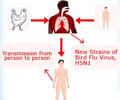The fatal risk that influenza poses even for children without underlying health conditions has been shown in new data being presented at IDWeek 2012TM.

One study viewed influenza from an epidemiological perspective, analyzing U.S. pediatric influenza-associated deaths over an eight-year period and finding that 43 percent of the deaths occurred in children with no health conditions, such as asthma or diabetes, that would have predisposed them to being at high risk of serious flu complications. Moreover, the study found that those young, previously healthy patients succumbed faster. The median duration of illness from onset of initial symptoms to death was four days in children with no underlying high-risk health conditions compared with seven days in children with at least one such condition.
"During the 2004-2012 influenza seasons, almost half the children who died had been previously healthy," said Karen K. Wong, MD, an Epidemic Intelligence Service officer with the Centers for Disease Control and Prevention (CDC) and the study's lead researcher. "The numbers demonstrate how important it is for all children, even children who are otherwise healthy, to get a flu vaccine every year, and underscore why all children with severe illness should get treated early with influenza antiviral medications."
The other study looked at influenza from a proactive perspective, assessing the impact of immunization programs in elementary schools in the Los Angeles area and finding lower rates of flu and higher rates of attendance. At one school where nearly half of the students received either a flu shot or the nasal spray, a "herd immunity" seemed to even safeguard the unvaccinated children.
"It's the school-aged children who spread the flu. They generally are contagious even when active, so they tend to be around other children, giving it to them and spreading it for longer periods of time," said lead researcher Pia Pannaraj, MD, an assistant professor of pediatrics at the University of Southern California and Children's Hospital Los Angeles. "It seems like the best place to prevent community spread of influenza is actually to go and prevent it at the school level."
This work is among the significant research being discussed at the inaugural IDWeek meeting, taking place through Sunday in San Diego. With the theme Advancing Science, Improving Care, IDWeek features the latest science and bench-to-bedside approaches in prevention, diagnosis, treatment, and epidemiology of infectious diseases, including HIV, across the lifespan. More than 1,500 abstracts from scientists in this country and internationally will be highlighted over the conference's five days.
Advertisement
"The findings underscore how severe the flu can be, even for children with no predisposing risk factors, and why all families should try to protect themselves against the virus," Kimberlin said. "School-based vaccination programs are a key strategy in that. The benefits are immediate and, if enough students get immunized, protection can extend to children not receiving vaccine. Public health officials will find these data very useful as they continue to work toward the goal of influenza control throughout the U.S. population."
Advertisement
The median age at death was 7. About a third of the children died in the emergency department or outside the hospital, the researchers found.
"Children with and without underlying medical conditions can die from influenza, and death can occur rapidly," Wong said. "Caregivers should be aware of early warning signs of severe influenza virus infection in children— including labored breathing, decreased fluid intake or urination, drowsiness or a lack of interaction— and should seek medical attention for them quickly."
But prevention is always better than treatment, and health experts agree that annual flu vaccination is the best protection. The National Advisory Committee on Immunization Practices recommends a flu vaccine for all children ages 6 months to 18 years old.
The impact of widespread vaccination not only protects the child but a community. As Pannaraj notes, school-aged children can easily share the virus with classmates, teachers and others in the normal course of a day. But within a school, they can just as easily – and quite efficiently – be immunized. "Schools are the best place for a campaign to prevent the spread of influenza," she said.
In the Los Angeles school-based vaccination study, Pannaraj and colleagues looked at eight elementary campuses with similar socio-demographic characteristics. Half were tagged as control schools and the other half as the intervention sites. Together they enrolled nearly 4,500 students.
During the 2010-11 academic year, between 27.8 percent and 47.3 percent of students in the intervention schools received at least one dose of flu vaccine. And as the flu season began that winter, children who came down with fever and flu-like symptoms at any of the eight schools were tested so that a diagnosis could be verified empirically. (In comparison to other studies of school-based programs, this one involved nose and throat swabs and documented absences.)
More than 1,000 specimens were obtained over a 15-week surveillance period. They showed that unvaccinated children in any school were 2.9 times more likely to get the flu compared to unvaccinated children. But they also showed that influenza rates were higher overall in the control schools – 5.5 per 100 children compared to 3.9 in the schools where immunizations had been given.
Not surprisingly, rates of absenteeism were also higher in the control schools (4.2 vs. 3.9 days per 100 school days), and students with the flu missed more school days than their peers with other respiratory viruses.
The one school where almost 50 percent of students were vaccinated got an unexpected bump. Researchers said that such widespread coverage seemed to better protect even the unvaccinated students, who were half as likely to get the flu as those in the control schools.
The research team interviewed parents and school officials to identify barriers to greater participation in such programs. Parents' concerns over vaccine safety was a prime issue, but an equally important factor was the support, or lack thereof, of front-office staff. If the clerks who answered the main phone line and fielded parents' questions were believers in the immunization program, then they often provided reassurance and promoted the effort. In turn, those schools recorded higher vaccination rates.
Source-Eurekalert










